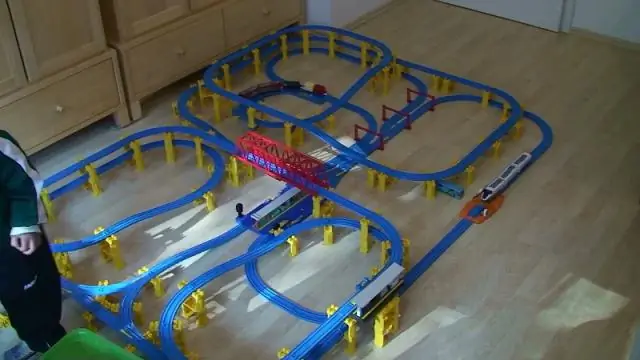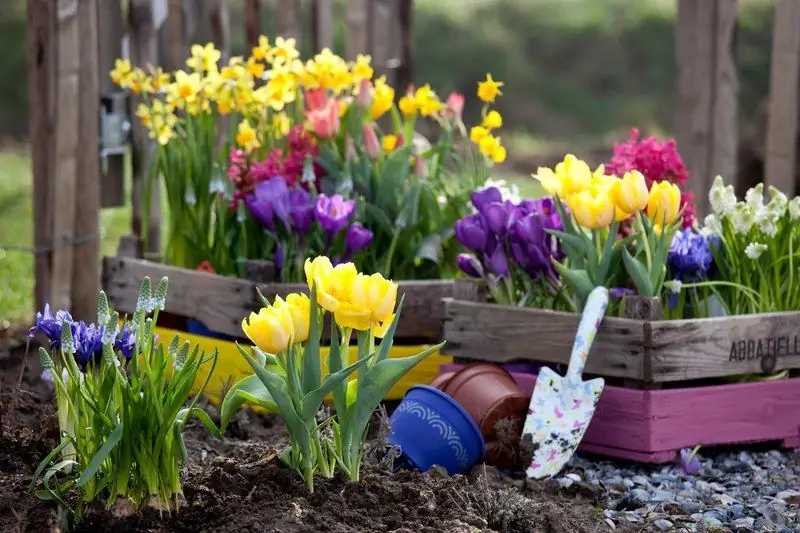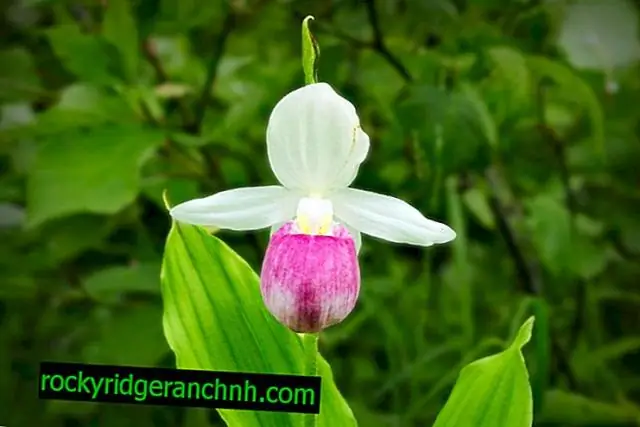
Table of contents:
- Luxurious gladioli on your site: rules for growing and care
- Growing basics: choosing a place, soil, varieties
- Gladiolus varieties suitable for growing in our latitudes (photo)
- Spring planting of tubers, seedling care
- Summer flower care
- Autumn chores: harvesting and storing tubers
- Video about growing gladioli
- Author Bailey Albertson [email protected].
- Public 2024-01-17 22:26.
- Last modified 2025-06-01 07:32.
Luxurious gladioli on your site: rules for growing and care

Austere and majestic gladioli are a real decoration of any flower garden and bouquet. Like everything beautiful, they will require careful attention from you. Therefore, we will tell you about the rules for growing and caring for gladioli so that they will delight you with flowering in the fall.
Content
- 1 The basics of growing: choosing a place, soil, varieties
- 2 Gladioli varieties suitable for cultivation in our latitudes (photo)
-
3 Spring planting of tubers, seedling care
- 3.1 More about landing patterns
- 3.2 Seedling care rules
- 4 Flower care in summer
- 5 Autumn chores: harvesting and storing tubers
- 6 Video about growing gladioli
Growing basics: choosing a place, soil, varieties
First of all, you need to find a place that is ideal for the growth of gladioli. The size of the inflorescences, the intensity and duration of flowering will depend on this. Gladioli like open areas that are well lit by the sun.
Intense sunlight is a prerequisite for the proper development of any bulbous plant. If gladioli stay in the shade for at least half of a sunny day, the ear ovary will be weak, no more than 5-6 flowers instead of the usual 12-13. Therefore, when planting bulbs, a distance should be observed: at least 3 meters must be retreated from trees and bushes so that the gladiolus receives the required amount of not only light, but also moisture.

A correctly selected area will be the key to good growth and flowering of gladioli
For gladioli, black soil will become a good soil. A mixture of loam and sandy loam, with a slightly acidic or neutral environment, is also perfect. Before planting gladioli, fluff the soil so that the soil is not excessively wet. Ideally, you need to dig up the site in the fall and fertilize it.
There are a huge number of varieties of gladioli. Modern breeding offers many colors and shapes - any flower will decorate your site, and if there are many of them, then you can create a real Garden of Eden. We invite you to pay attention to several varieties that are excellent for growing in our latitudes. These gladioli do not require any special care from you:
- The raspberry miracle is a large-flowered tall variety that multiplies quickly;
- Blue sky - super-corrugated variety, powerful trunk, large flowers;
- Marble fantasy - tall, large-flowered, soft color of inflorescences;
- Priscilla - large flowers, color of three contrasting shades, turning into each other;
- Zorro - juicy red large flowers;
- Aelita - purple-lilac color, unusual flower shape.
Of course, these are far from all varieties that are unpretentious in our climate. Check out our gallery of gladioli, you will surely be able to find flowers to your liking.
Gladiolus varieties suitable for growing in our latitudes (photo)
-

Gladiolus Wine and Roses - Wine and Roses
-

Gladiolus Violetta - Violetta
-

Gladiolus Raspberry Tale - Gladiolus Raspberry Tale
-

Green woodpecker - Green Gladiolus Green Woodpecker
-

Gladiolus varieties of montesuma - The original Montezuma variety
-

Gladiolus varieties aelita -
Lavender gladiolus Aelita
-

Gladiolus Rosa in emerald - Dew in emerald
-

Gladiolus varieties atom - Variety Atom
-

Gladiolus variety Russian beauty - Variety Russian beauty
-

Abby Gladiolus - Abby
Spring planting of tubers, seedling care
The planting time for gladioli is the end of April and the first decade of May. At this time, the soil has already warmed up and dried up enough.
- Prepare the gladioli bulbs 2 weeks before planting. Clean them from crusts and scales, inspect for pests. Rotten or infected tubers (if the affected area is too large) must be destroyed.
- Check the bulbs for diseases. If they are found, they can be treated. Cut off the damaged area and treat with an antiseptic. It is necessary to plant such tubers a little later, when the wounds are dry and healed.
-
Vernalize 2-3 days before planting. Arrange the tubers in a warm, bright place without direct sunlight. The air temperature should be 22-27 degrees.

sprouted gladiolus bulbs It is best to plant the bulbs in the ground after the sprout appears.
- Treat the bulbs with a disinfectant solution just before planting. At home, a weak solution of manganese is suitable.
- Baby bulbs should be cleaned immediately before planting in the ground.
For tubers of different sizes, the planting depth in open ground will be different. For example:
- bulbs over 2 cm in diameter - 5-10 cm deep;
- medium tubers 1-3 cm in diameter - 4-7 cm deep;
- small bulbs about 1 cm in diameter (including children) - 3-5 cm deep.
For adult gladioli, it will be better if the tubers are planted at a distance of 15 to 20 cm. It is advisable to make the same distance between the rows. Small gladioli tubers can be planted closer.
More about landing patterns
Usually, a ribbon landing pattern is used - one-line or two-line.
With a one-line scheme, the distance between the rows is from 40 to 70 cm; the distance between the bulbs, depending on the size, is 8-10 or 5-7 cm. Thus, 27-30 large bulbs are planted per 1 square meter. m or up to 45 small pieces, for growing.

One-liner tape landing
The two-line scheme implies the distance between the ribbons 70 cm, between the lines in the ribbon 15 cm, between the plants in a row 8-10 cm. You can bring the distance between the lines in the ribbon closer to 5-7 cm, increasing the distance between the ribbons to 90 cm. m can accommodate 27-35 large tubers. When growing small bulbs per square meter, they are placed up to 45 pieces.
Seedling care rules
After the first shoots have appeared, you can start watering. You need to carry it out as needed. In spring, the soil is still quite moist, but by the end of May, hot weather can set in. Do not allow the soil to dry out, and at the same time - its waterlogging.
When flower stalks begin to form, you can increase the amount of irrigation - about 10-15 liters per 1 sq. M. You can determine this period by the number of leaves - at least 3 full sheets.

Carefully look after the seedlings: water them in a timely manner and spray them from pests
During the growth period, gladioli may need feeding. Nitrogen fertilizers work well for this. The first top dressing can be applied at 4 weeks after planting, the second at 6-8 weeks. You will need about 25-30 g of fertilizer per 1 sq. m of soil. If the soil in your area is rich in nitrogen, you can double the amount of fertilizer. After the first buds appear, feed the soil again. The area should be watered before fertilizing.
Be sure to weed the bed with gladioli and mulch the soil. Literally 3-5 cm of peat or humus will retain moisture in the soil and provide ventilation.
Summer flower care
Gladioli begin to bloom in early August. During this period, they especially need moisture: flowering requires a lot of energy from the plant, and the soil has already dried out over the summer and depleted its resources. Try to water the flowers more often, constantly loosening the soil and hilling each plant. Do not forget to pull out the weeds: they inhibit the growth of flowers.
Hilling gladioli will help the stem to strengthen and stay upright. If you think that the plant is too large and may not be able to withstand its own weight, tie the stem to a peg, which gently stick it into the ground at a distance from the flower so as not to damage the bulb.
During the summer growth and flowering period, gladiolus can be especially susceptible to diseases and pests. Do not forget to spray the flowers with disinfectants and protective agents.

Blooming gladioli for bouquets must be cut according to the rules
You also need to cut gladioli for bouquets according to the rules. It depends on how long the flower will stand in the water and how well the bulb will develop.
You can cut gladiolus after the first bud picks up color and begins to bloom. Such a flower can be stored much longer. If you do not plan to transport flowers, and you need a bouquet right now, 3-4 blossoming buds are allowed.
Cut gladioli early in the morning before the sun is hot. The best collection method is considered to be "breaking". Take a sharp awl, move the leaves apart, make a hole at their base. Keeping your hand close to this spot, gently break the stem. This will keep the leaves intact and protect the stem from possible infection.
Autumn chores: harvesting and storing tubers
In autumn, the bulbs of gladioli must be dug up, because they are very afraid of the cold, and in winter they will die in the soil. The tubers are harvested from mid-September, about 40 days after the beginning of flowering.
The weather at the time of excavation should be dry and relatively warm. Before removing the bulbs with children from the soil, cut the stems with a pruner.
A shovel can seriously damage the rhizomes, so it is better to use a pitchfork for digging.
After you have removed all the bulbs, put them in boxes with a lattice or mesh, rinse in running water and disinfect with a solution of manganese or basezol, then dry them for 3 days.

Be sure to sort the bulbs before storing.
The best place to store gladiolus bulbs is in a cool basement or underfloor with good ventilation. Sort out adult bulbs and babies before storing and check for lesions and damage. Place clean, healthy tubers in small boxes and store on shelves.
If you plan to store seed at home, wrap each bulb in paper, place the tubers in tightly sealed plastic containers and place them on the bottom shelf of the refrigerator. They should be removed periodically, ventilated and checked for damage. Tubers that are in doubt are best harvested.
Video about growing gladioli
We hope our tips will help you grow majestic, beautiful gladioli, and use them to turn your garden into a fabulous corner. If you have any questions about this topic, please ask them in the comments. There you can also share your experience in growing gladioli. Good luck to you!
Recommended:
The Washing Machine Does Not Open After Washing: What To Do, How To Unlock The Lock And Open The Door, Including During An Unfinished Wash

Why is the washing machine door blocked after washing. How devices of different models open. How to open the hatch on your own. What not to do. Photo and video
How To Plant And Grow Cucumbers In The Open Field: Plant Seeds, Properly Care For Plants (water, Form, Tie Up)

What varieties and hybrids of cucumbers can be grown in the open field. Features of planting seeds and seedlings. Choice of place and timing. The nuances of care and formation
Planting Tulips In Spring: When And How To Plant Correctly In Open Ground And Pots

How to properly plant tulips in spring in soil and pots. When tulips are planted in spring, favorable days for planting according to the lunar calendar, nuances for the regions
Growing Pepper Seedlings At Home: When To Plant According To The Lunar Calendar 2019, On The Windowsill, In The Greenhouse And Not Only With Video

How to prepare everything you need for growing pepper seedlings at home, sow seeds and grow in a suitable way for a gardener
Why Do Tomatoes Crack And Burst (on A Bush In An Open Field And In A Greenhouse), What To Do

Why do tomatoes crack and burst (on a bush in an open field and in a greenhouse). How to deal with the problem
